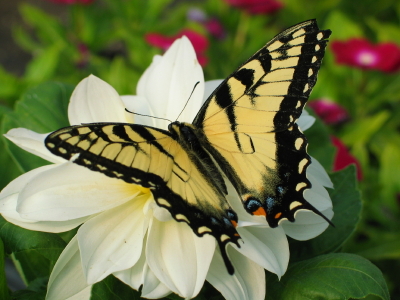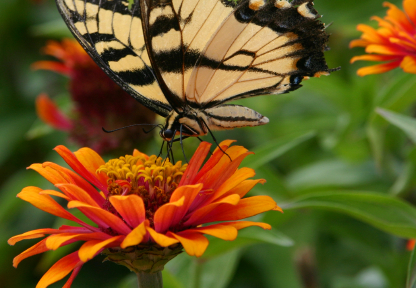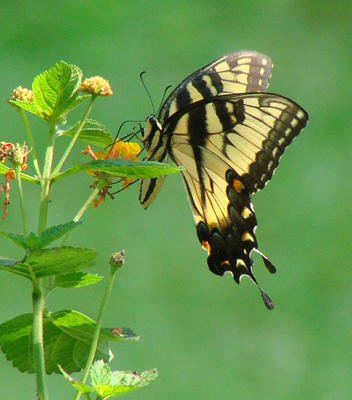South Carolina  SC Facts & Firsts
SC Facts & Firsts  SC State Symbols
SC State Symbols  SC State Butterfly
SC State Butterfly
SC State Butterfly – Eastern Tiger Swallowtail
The Eastern Tiger Swallowtail, or
Papilio glaucus, is the state butterfly of South Carolina. This symbol was adopted in 1994 with the approval of
Act 319 of the South Carolina General Assembly.

Eastern Tiger Swallowtail with Wings Spread
Butterflies have four wings – two larger sections called fore wings, and two smaller sections called hind wings. Swallowtails are named for the long portion of their hind wings which resemble a swallow's tail feathers. Each of the fore wings of the Eastern Tiger Swallowtail has four black stripes resembling a tiger. Males are yellow with black stripes, while females can be either yellow or dark gray with the same striped pattern. Often males will have a small portion of vivid color, but females always have orange and blue spots on the lower edge of the hind wing.
The female Eastern Tiger Swallowtail can produce up to three "broods" each year. They do this by laying small, round eggs on the upper leaves of host trees such as Poplar, Black Willow, Red Maple, or Elm. When the egg hatches, the larva (or caterpillar) eats the egg's shell, then dines on the leaves of the plant or tree on which it hatched.

Side View of the Eastern Tiger Swallowtail
Over the course of weeks, the larva grows to about two inches long and molts several times. At first, the larva resembles bird "poop" in order to ward off predators such as birds and raccoons. When it is plump and green, the caterpillar develops two "eyespots" – yellow spots with black centers which resemble eyes. Eyespots help protect them from potential predators.
During the next stage, the larva turns into a pupa by wrapping itself into a leaf and securing it with silk. At this stage, the pupa is called a
chrysalis, and it neither eats nor drinks while inside its cocoon. Over the next several weeks, it will transform into a butterfly and emerge ready to take flight.
Butterflies do not eat solid foods as they did in their larval stage. Instead, they sip nectar from a variety of flowers using a
proboscis – a long, tube-shaped tongue. Such flowers include honeysuckle, lilac, and black-eyed susans among others. The entire process of development – from egg to butterfly – only takes a about a month! Adult Eastern Tiger Swallowtails are considered large, with a wingspan between three and six inches.
 |
 |
| Bill Proude © 2010 |
Bill Proude © 2010 |
More on the SC State Butterfly – Eastern Tiger Swallowtail
Act 319 – South Carolina's State Butterfly
- South Carolina Legislative Act 319 declared:
AN ACT TO AMEND THE CODE OF LAWS OF SOUTH CAROLINA, 1976, BY ADDING SECTION 1-1-647 SO AS TO DESIGNATE THE TIGER SWALLOWTAIL AS THE OFFICIAL STATE BUTTERFLY.
Whereas, the tiger swallowtail, a large, yellow, black-striped butterfly, is one of the most familiar butterflies in North America and is one of the most common and conspicuous butterflies in the Eastern United States; and
Whereas, documentation of this butterfly in South Carolina dates back to 1725 when it was painted with a native shrub by an English painter, Mark Catesby; and
Whereas, the Garden Club of South Carolina has identified the tiger swallowtail as of particular interest to South Carolinians because it can be seen in deciduous woods, along streams, rivers, and wooded swamps, and in towns and cities throughout South Carolina. Now, therefore,
Be it enacted by the General Assembly of the State of South Carolina:
Official state butterfly
SECTION 1. The 1976 Code is amended by adding:
"Section 1-1-647. The tiger swallowtail is designated as the official state butterfly."
Time effective
SECTION 2. This act takes effect upon approval by the Governor.
Approved the 29th day of March, 1994.




